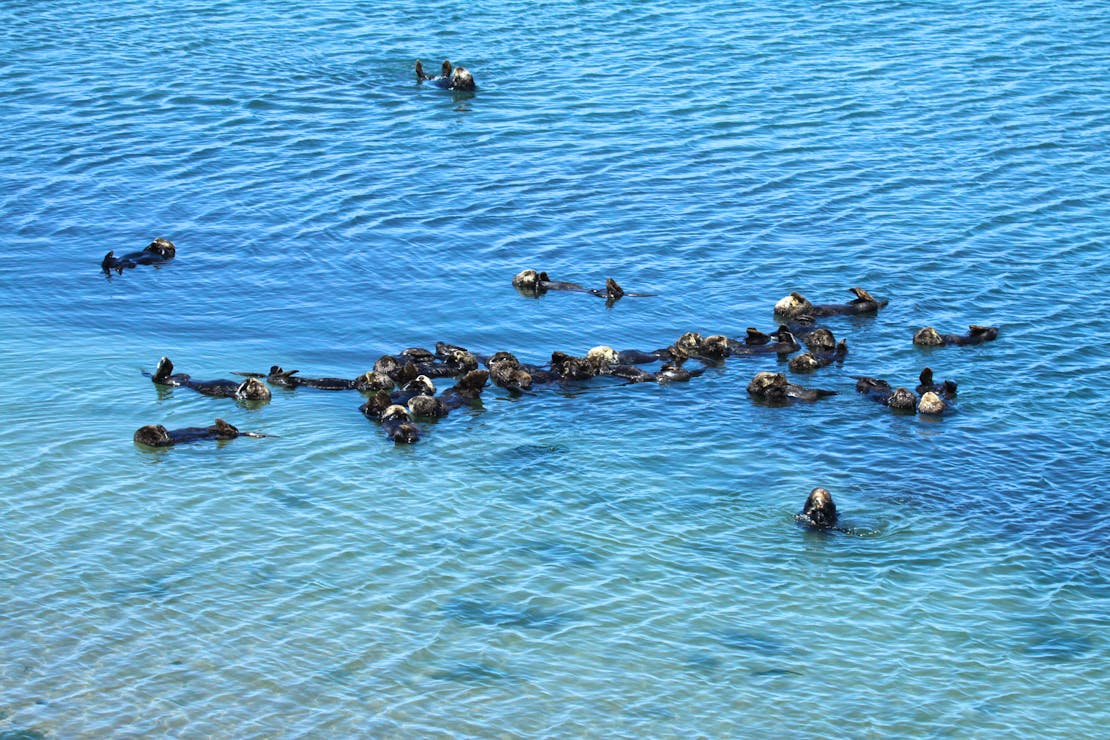Bewhiskered and adorable, sea otters floating offshore are more than just bundles of furry cuteness. They play a vital role in nearshore ecosystems, generating cascading effects in kelp forests and estuaries that promote coastal resilience and benefit local communities.
To broaden public acceptance and understanding about the vital role sea otters play and the need to coexist with and protect them, Defenders established the third week in September 2003 as Sea Otter Awareness Week. Since then, Defenders and our many partners have championed the sea otter each September through in-person events and activities. This year, because of the continuing pandemic, we’ve encouraged participating groups and organizations to take the annual celebration virtual. Through webinars and livestreams, we’ve continued to inspire a deeper awareness of the ecological importance of sea otters and an understanding of the many challenges they face.
Sea otters once ranged around the rim of the North Pacific Ocean, from Japan to Baja California, but humans hunted them to the brink of extinction during the fur trade of the 1800s. Due to conservation efforts, southern sea otters have repopulated about 13% of their historical range. Today, southern sea otters are found in central California and northern sea otters are found in parts of Washington, British Columbia and Alaska. They have yet to reclaim their full historical range in Northern California and Oregon. All sea otters are protected under the Marine Mammal Protection Act, and those in California and Southwest Alaska are listed as threatened under the federal Endangered Species Act.
Defenders’ California, Northwest and Alaska programs have united to strengthen our sea otter programs through awareness and public engagement. We are actively working to highlight the complex and critical ecological role of this keystone species by consolidating our resources and advancing creative strategies to restore sea otters throughout their historical range and mitigate conflicts.
In July, we presented a joint webinar with the Elakha Alliance about the potential for reintroducing sea otters to Oregon waters based on restoration efforts in other areas. Since the fur trade of the 1800s, sea otters have not repopulated Oregon’s coastal waters. The Elakha Alliance is leading the effort in Oregon to assess the ecological, social and economic complexities of a possible reintroduction of sea otters to the Oregon coast. In addition to providing critical ecosystem services, sea otters have a long, deep connection with indigenous tribes in the area. Our presentation invited discussion about recent research and techniques that could inform this reintroduction initiative.
In August, Friends of the Sea Otter discontinued operations after more than 50 years of pioneering work conserving sea otters and transferred its assets to Defenders. We’re proud to expand upon Friends of the Sea Otter’s legacy of protection, advocacy and restoration work.
In September, a Defenders-sponsored bill passed in the California legislature that will establish the California Sea Otter Voluntary Tax Contribution Fund on the California Resident Income Tax Return until 2028. This critical funding source will help support ongoing conservation research, law enforcement activities and community outreach programs.
One of our sea otter conservation partners is Sea Otter Savvy, a nonprofit dedicated to reducing sea otter disturbance. We collaborate closely with this group on new strategies for coexisting with sea otters, and we just put the finishing touches on an interactive storymap showing the historical range of sea otters, recounting the fur trade, highlighting areas for sea otter disturbance and mapping areas for respectful viewing of otters in the wild.
Despite all these positive activities, a concerted federal strategy for managing sea otters remains elusive. For example, the 18-year-old federal recovery plan for southern sea otters, mandated under the Endangered Species Act, requires extensive revision because much of the scientific data upon which it was based are no longer relevant. And research on and monitoring of southern sea otters has dwindled. Because of the pandemic, the annual count of sea otters in California didn’t take place this year for the first time in nearly 40 years, and large-scale field research on the California population has all but ceased after more than 20 years of intensive tagging and monitoring studies.
Although Sea Otter Awareness Week only rolls around every September, Defenders works year-round to help ensure sea otters recover. Our efforts include:
- encouraging the U.S. Fish and Wildlife Service to update and revise its recovery plan for the southern sea otter.
- helping to develop strategies for sea otters to expand into areas of their historical range.
- engaging with federal, state and local stakeholders to address conflicts between sea otters and fisheries in Alaska.
- working with agency colleagues, field scientists and communities to find better ways to coexist with sea otters wherever they occur.
To protect sea otters—and all our wildlife—it takes all of us.












